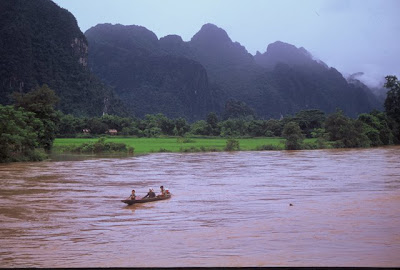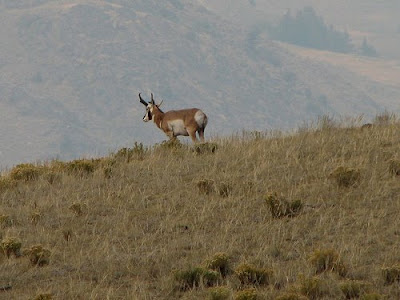 Pawn a local advocate of environmental protection and sustainable tourism
Pawn a local advocate of environmental protection and sustainable tourismI think some background is in order.
Just about a year ago the co owner of the Boat Landing Guest house in Luang Namtha disappeared while enroute to an appointment with the police to discuss the recent attempted arson of his eco lodge by unknown parties. Nothing was heard from him since.
I, like many other people who didn't know him, and weren't intimately familiar with the local situation in Luang Namtha, could imagine many scenarios where he might have had conflicting interests with rubber plantation developers, loggers, the government agencies carrying on relocation of upland peoples on a massive scale, or more mundane private matters, loss of face, jealously, who knows what.
Bertil Lintner the writer of this artical has a long and very good reputation for reporting on Burma, North Korea and other reclusive regimes of East Asia. One would have to assume he has good sources in this case. Mr. Lintner is the only public new news from a reputable source I've seen since the incident first occured.
Asia TimesSoutheast Asia
Feb 2, 2008
Fear of foreigners in Laos
By Bertil Lintner
LUANG PRABANG, Laos - It is has been one year since Sompawn Khantisouk was abducted by men believed to be local police officers. The whereabouts of the entrepreneur, the owner and manager of a small eco-tourism lodge in northern Laos, are still unknown - indeed, no one other than his abductors even knows if he is still alive.
Many at the time assumed he was taken away as punishment for trying to mobilize local villagers in the area against Chinese-sponsored rubber plantation projects. Now it seems more likely that Sompawn was victim to a new and pressing dilemma facing one of the world's last remaining communist-ruled countries: how to balance rapid market-driven economic growth with the strict
social controls that the Lao People’s Revolutionary Party has kept in place since it assumed power in 1975.
Sompawn ran the famous Boat-Landing resort, which is mentioned in most foreign guide books to Laos and had won several awards for its contribution to environmentally sound sustainable tourism. Eco-tourism promotion is even listed as one of the Lao government's five main development priorities, along with hydroelectric power, construction materials, agriculture and mining.
Last July, Laos hosted an Ecotourism Forum, which brought together tour operators, travel agents, hoteliers, development agencies and government authorities from throughout the Mekong river region. Those efforts have won significant international plaudits, including a New York Times survey that recently ranked Laos as the world’s top adventure tourism spot in 2008.
At the same time, there are entrenched official fears about growing foreign influence in the country, particularly in remote rural areas. Sompawn's partner was an American citizen and the country's security agencies were reportedly not pleased to see a foreigner help run the successful business. At about the time Sompawn disappeared, his American partner left the country and has not since returned.
Soon thereafter, at least two foreign non-governmental organizations (NGOs) were ordered out of Luang Nam Tha, the province where the Boat-Landing is located. Other, lesser-known operators of small local businesses with foreign links were threatened with expulsion or stricter supervision of their activities, according to sources in northern Laos.
"On the one hand, the government welcomes the foreign revenue from tourism, while on the other it fears the security implications of allowing tourists to wonder at will around the country," wrote Song Kinh, an article published in the Irrawaddy news magazine. Officials overseeing the fast-growing tourism sector tend to be somewhat more accommodating to foreigners, while security personnel are less so.
The latter are particularly suspicious of foreign-run NGOs, many of which work to empower local communities by teaching them basic democratic principles and which security officials see as a challenge to the authority of the ruling Lao People's Revolutionary Party, the country’s only political party. While Sompawn's local business was not an NGO, many of its tourism activities were done in close consultation with local communities.
Foreign devils
As a legacy of wars in the 1950s, 1960s and 1970s, first against the French and then against the US in what the Lao government refers to as "the 30-year struggle", the country's communist rulers remain wary of foreign influences. For instance, some of the NGOs that have been targeted for harassment are known to have had Christian connections.
While the vast majority of the country's lowlanders are Buddhist, Christianity has made inroads in the highlands, home of several ethnic minorities that have a long history of resistance to integration into mainstream Lao society. There are historical reasons for their squeamishness. During the Indochina conflict, thousands of Hmong tribesmen - although ostensibly part of the then Royal Lao Army - were armed and equipped by the American Central Intelligence Agency to fight the communist Pathet Lao, which, in the end, emerged victorious in the war.
Then American Christian missionaries worked more or less openly for the CIA, among them the legendary Edgar "Pop" Buell, an Indiana farmer who was assigned to the Xieng Khouang area in and around the Plain of Jars, where he came into contact with the Hmong. Later, he became the principal contact man between the CIA and the Hmong, working closely with the Hmong warlord Vang Pao, who escaped to the US before the communist takeover in 1975, and, despite his now advanced age, has continued to campaign against the country's communist rulers.
In June last year, the authorities in California arrested him on charges of masterminding a plot to overthrow the Lao government with arms and equipment that were ready to be shipped to Thailand. Eight others were also arrested and charged with violating the federal US Neutrality Act, among them a former California National Guard, Lieutenant Colonel Harrison Ulrich Jack, a 1968 West Point graduate who was involved in covert operations during the Vietnam War.
The other seven were all Hmong from Laos who had been resettled in the US after the end of the war. The criminal complaint said Vang Pao and the other defendants plotted an insurgent campaign, "by violent means, including murder, assaults on both military and civilian officials in Laos and the destruction of buildings and property". In July, he was released on bail.
However, the events in California had repercussions in Thailand, where in a bid to ease bilateral tensions the government announced that it would repatriate thousands of Hmong refugees back to Laos. Now totaling about 8,000, their numbers have swelled in recent years due to fresh arrivals, indicating that all is not well in the Lao mountains. Although the Hmong insurgency, which simmered on throughout the 1980s and into the 1990s, is now more or less over, there are reports of occasional skirmishes and ambushes involving hill-tribe bands, mostly in the area around Phou Bia mountains south of the Plain of Jars, and near the town of Kasi on the main road between Vientiane and Luang Prabang.
With the revelations of a Vang Pao's latest plot, the already paranoid security authorities in Laos may have seen a broader US conspiracy in the eco-tourism joint venture they broke up with Sompawn's abduction and the US citizen fleeing the country. They may also have read with some suspicion the US State Department's International Religious Freedom Reports, which frequently mention "abuses of citizen's religious freedom" in Laos, especially arrests of Christians and actions taken against the independent Lao Evangelical Church (LEC). The 2007 report mentions closure of LEC-affiliated churches and the detention without charges of local Christian community leaders.
Costly xenophobia
With that bad publicity, the security authorities seem to believe that remote provinces such as Luang Nam Tha are better cleansed of foreign, especially Western, influences. Wealthy Chinese tourists to the newly opened casino on the Lao side of the frontier at Boten bring in only money, not new potentially destabilizing ideas about human rights and democracy, so they remain welcome. Aloon Dalaloy, vice governor of Luang Nam Tha, is reported to have told a public gathering in the province last year that "we are still fighting the revolution, not against the enemy's bombs and guns, but the Americans and the Christians are still our enemies."
Such rhetoric, of course, overlooks the more pressing national challenges the transition to a free-market economy represents. As the Lao economy continues is rapid expansion, with gross domestic product growth up over 7% in the past two years, there is an acute and growing shortage of skilled labor. And there is no remedy in sight, unless the government moves to employ more outside experts. In a paper dated December 14, 2007, the Asia Foundation pointed out that Laos has only one university, which opened only 11 years ago. Prior to that, students were sent to the Soviet Union, Bulgaria, Poland and other Eastern Bloc countries for higher education, but that training is often irrelevant to the country’s current human needs.
When the National University of Laos enrolled its first class in 1996, there were just over 8,000 students. Today there are nearly 27,000 at the university, but, the Asia Foundation says, the shortage of human and economic resources poses constant challenges and most faculty members have no degree beyond bachelor's level. With the country's few skilled professionals opting to work in better-paying foreign-led private enterprises, according to the Asia Foundation, it is hard "to imagine how departments like engineering, natural sciences and business will be able to keep their best and brightest teachers, all but eliminating the mechanism for building a future generation of capable Lao professionals".
That means the Lao government can either dramatically raise the salaries of professors and technocrats, or employ more foreigners to fill the gaps - and hope that foreign donors will pay for their much higher expatriate salaries. But that also means more foreign influences, not only in sectors like ecotourism and small-scale rural development schemes but in central government institutions as well. That arguably would pose an even graver threat to central control than foreign-managed eco-tourism resorts or NGO and missionary activities in politically sensitive highland areas.
The ruling Lao People's Revolutionary Party has arrived at a crucial crossroads and the direction pursued will likely make or break its still tentative economic reform experiment. Clearly there are still elements in the party who are reluctant to change their repressive ways, accept new social and economic realities and move the country forward.
Sompawn’s arrest and disappearance is testament to that inertia. But with the country's greater integration into the global economy, party officials will sooner or later have to face the fact that even landlocked Laos cannot remain insulated from foreign influences.
Bertil Lintner is a former correspondent with the Far Eastern Economic Review, for which he wrote frequently on Lao politics and economics. He is currently a writer with Asia-Pacific Media Services.

















